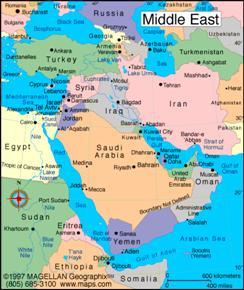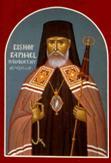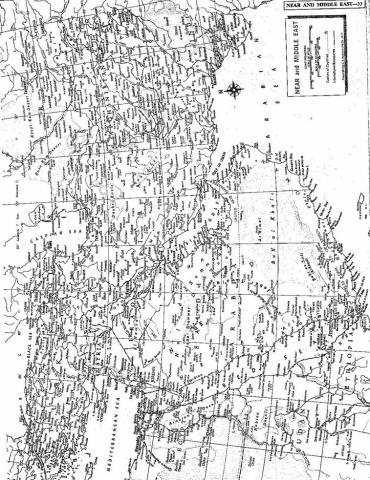National Churches: Antioch
UNIT 12: NATIONAL CHURCHES
Objective: For each church discuss its founding, its history since 1500, and its present status abroad and in the US. Students should understand the difference between culture and ethnic orthodoxy – Tradition vs. tradition.
The academic material for the “country of the week” can be easily copied and divided for each student to read one section and present to the class. The inclusion of geography and political history may seem strange, but Church history does not happen in a vacuum. Take every opportunity to tie the two together – e.g., why did St. Nicholas of Japan take a boat from Russia to his mission? Because Japan is an island nation situated next to Russia.
While the lesson contains the usual dry academic matter, these churches are alive in our Orthodox culture in America. We’ll skip the usual learning game and make do with some quick quiz questions in order to make time for your “cross-cultural” experience. Make the people of these countries alive to your students, while not ignoring the facts to be presented. Can each student bring in a sample of his favorite ethnic food from that culture? How about a speaker from the parish who is of the national background being discussed? Samples of ethnic clothing to try on? A trip to a restaurant? As you sample these “traditions”, try to help the students distinguish this ethnic milieu from Holy Tradition – the writings of the Church Fathers and the decisions of the Ecumenical Councils.

WEEK 1: ANTIOCH
Geography:
The See of Antioch is today the See of the Arabic Christians, a minority in each of the Arabic nations. The Arabic peoples live in 19 countries in northern Africa and southwestern Asia. Look at the map on the next pages and locate Arabia, Syria, Iraq, Jordan, Lebanon, and Palestine (Israel) – the Middle East. Vast deserts cover larges expanses of land; each country has some mountainous regions as well. Climate has wide ranges of temperature, from freezing at night to 120 degrees in the daytime. Thus, most of the people make their homes along the Mediterranean or in the river valleys. Forests are scarce, transportation varies from camel to airplane, and everything in between. Most of the people are farmers; some are nomads (or Bedouins). If you have time to go to the library, get a book with pictures of the various Arabic countries and peoples.
Early Roots:
In the days of the apostles, Antioch was an important city in northern Syria. Locate it on a map. It was the capital of the Province of Syria and the third largest city of the Empire, after Rome and Alexandria. From here, St. Paul was sent out on his missionary travels; it was his “home base.” And, in Antioch, believers were first called Christians.
As the Church developed a hierarchy, five of the bishops of the early Church became recognized as “Patriarchs.” This was a title of honor and respect, not of authority. Antioch (along with which 4 others?) was one of the original 5 Patriarchates.
Moslem Rule:
In the year 683, the city of Antioch fell to Moslem invaders. The earliest Moslem invaders were of the Caliphate of Abu Bakr, who united Syria with Egypt, Jordan, Lebanon, and Iraq. Alexandria and Jerusalem were captured. With three of the four Eastern patriarchates captured, only Constantinople remained free. It grew in importance. Often the Patriarch of Antioch had to reside in Constantinople in exile. Soon the Patriarch of Antioch was appointed from Constantinople, a situation that continued even after the Turks conquered Constantinople.
Another invader came in the 12th century – the Crusaders. Review the Crusades if time allows. The Crusaders occupied Antioch in 1099 and replaced the Orthodox Patriarch and bishops with Roman Catholic ones. For 150 years the See of Antioch was ruled by the Romans.
By the 7th century, the caliphs had moved their capital to Damascus in Syria. The seat of the Patriarch of Antioch had also been moved to Damascus, the new capital of Syria. This move, forced by the conquerors, led the Antiochian Orthodox Church to be identified with specifically the Arabic Christians, as it is today. By the mid-1500s, the Ottoman Empire led by a group of Turks, ruled most of the Arab lands. In 1603, the great Balamand monastery and school was reopened in an ancient building used first by Orthodox, then by Roman Catholic monks, and then vacant for 300 years. In the 1800s a seminary was added here to train priests and deacons for Arabic Christian churches. The Ottoman Empire began to decline in the 1700s; would the Arabic peoples now be free of foreign domination?
Next, European powers carved up the Arabic peoples. France and England were especially interested in enlarging their spheres of influence. France took Algeria and England took Egypt. With the 18th century, the Jesuits came to Syria seeking converts to Roman Catholicism. They took some Orthodox away from their roots; this became known as the Melkite schism. The see of Antioch was further weakened and diminished in numbers. But, Orthodox brethren in Russia were ready to help, offering financial support in the 1800s and inviting men to come to Russia for theological education. They helped set up schools, hospitals and rebuilt churches and monasteries, shining the light of Christ for all to see.
The Ottoman Empire fell with their defeat in World War I (on the side of Germany). The League of Nations gave Iraq and Palestine to England and Lebanon and Syria to France. In the 1920s and 1930s rebellion broke out all over the Arabic world, seeking independence.
The most recent threat to peace in the Arab world has been the formation of the Jewish state of Israel, given its independence by England in 1948. Jewish people around the world argued forcefully for their right to their ancient homeland as a safe haven from the persecution and slaughter experienced under Hitler. Palestinian Arabs violently protested this move and continue to violently oppose the very existence of a Jewish state in land that had been theirs for centuries. Many have been made refugees due to the numerous conflicts in the last decades. How will it end?
St. Raphael Hawaweeny:
Raphael was born in Syria in 1860 – just 150 years ago. But, in Syria Christians were still being persecuted, now by the Moslems and not by the Romans, and his family had to flee to Beirut, Lebanon, when he was a baby. Later, they returned to Damascus in Syria. There Raphael was a very good student in school. His parents were too poor to pay for his schooling, but the Deacon Athanasios asked the church to pay. Young Raphael was studying to be a priest. In fact, he was such a good student, that soon he was helping to teach. In seminary, Raphael was ordained a deacon; remember what a deacon was? He then studied in Halki, near Constantinople. But, he still wanted to learn, and he was sent to the Academy of Kiev in Russia. There he learned Russian and was ordained a priest, head of the Arabic Antiochian church in Russia. He stayed in Russia as a teacher.
But a call went out for someone to go to the new lands in America. Arabic Christians had begun to immigrate to the US in about 1878 because of persecution by the Ottoman Turks in their homelands. Most of them stayed initially in the New York area. There were Arabic Orthodox Christians there without a pastor. Fr. Raphael set off across the ocean under the auspices of the Russian Orthodox Church. In less than 2 weeks, he had set up a chapel in New York and was celebrating services. The chapel was blessed by the Russian Bishop Nicholas – the head of all Orthodox in America. Remember from the last unit that, until 1917, all Orthodox in America were under the Russian hierarchy. So, Fr. Raphael, from Syria, was a Russian Orthodox priest!
Soon, Fr. Raphael heard of small communities of Arab Christians all over the continent. Many of these had no priest, no church. Who would help them maintain their Orthodox faith in this strange land, full of Protestants and Roman Catholics? Fr. Raphael set out across the country – to San Francisco and back. Follow his journey on your world map or globe. Remember there were no airplanes or cars in 1896; all travel was by train or boat. He performed marriages, baptisms, confessions, liturgies – often in homes where there was no church. For these Arab Christians, he produced an Arabic language service book. Later he would also begin the Arabic Christian magazine, “The Word”, still published today.
Fr. Raphael saw the need for more Arabic-speaking priests and received the Russian bishop’s blessing to bring many over from Syria. He traveled again around the country, visiting 43 cities and towns. He ministered to Greeks and Russians, too, all part of the Orthodox flock in America. Back in New York, he worked hard to provide a real church for the Syrian Christians in New York and a cemetery of their ow n. Bishop Tikhon himself (Remember him from the last unit?) came to consecrate the new St. Nicholas Church in Brooklyn. Fr. Raphael loved America and, even when offered the role of bishop back in Syria, chose to stay in his new country. He learned English and began to use English in services and Church School.
n. Bishop Tikhon himself (Remember him from the last unit?) came to consecrate the new St. Nicholas Church in Brooklyn. Fr. Raphael loved America and, even when offered the role of bishop back in Syria, chose to stay in his new country. He learned English and began to use English in services and Church School.
After many years, the new Russian bishop said that he needed more bishops for the ever-growing church in America. Fr. Raphael was ordained a bishop in 1904 in New York – the first Orthodox bishop ever consecrated on American soil – Bishop of Brooklyn. As bishop, he ordained priests and started new parishes. He consecrated the grounds of St. Tikhon’s Monastery in Pennsylvania. He even traveled to Canada and Mexico. Finally, in 1915, Bishop Raphael Hawaweeny went home to be with his Lord, dying in his sleep. In the year 2000 he was named a saint, to be remembered on February 27, the day of his death.
Today:
With the Russian Revolution, coming on the heels of the death of their beloved leader, the Church in the US was without the financial and spiritual support of Moscow. When Metropolitan Germanos came from Syria to collect money to help the See of Antioch, many Arabs wanted him for their own leader and he proclaimed himself as representing the Patriarch of Antioch.
By 1934, most of the Arabic parishes were aligned with the Antiochian Patriarch, who sent Archimandrite Antony Bashir from the Balamand Academy to be their leader. The Arabic community drew together under this capable man, who was then consecrated bishop in 1936. He worked tirelessly for the idea of American Orthodoxy – welcoming converts, using English in services, promoting Christian education. He helped to found SCOBA, the Standing Conference of Canonical Orthodox Bishops in the Americas – a unifying force among the various ethnic traditions. Bishop Antony died in 1966.
Philip Saliba succeeded Antony Bashir. Philip was also educated at Balamand. He spent years as a parish priest in Cleveland. In 1966 he was elected Metropolitan of New York and North America for the Antiochian Orthodox Church. Metropolitan Philip has worked to support youth ministry, ecumenical activities, missions all over the world, and Middle East relief. He welcomed the churches and priests of the Evangelical Orthodox Church, who sought in 1986 to reunite with its Orthodox roots.
Cultural tradition:
What wonderful foods do we enjoy that are of Arabic tradition? Tabouleh, hummus, pita bread, lamb, dates, and almonds come to mind. Share experiences with the students.
Look with your speaker, or in your library books, for pictures of people in traditional dress, traditional dancing, traditional housing.
Quiz Questions:
- List at least 5 foreign powers who have ruled the Arabic people.
- Describe the life of St. Raphael in 4 sentences.
- List the three bishops who have led the Arabic Christians in America.
Primstav: Add St. Raphael Hawaweeny on February 27. How should he be symbolized?
Close with Prayer.
